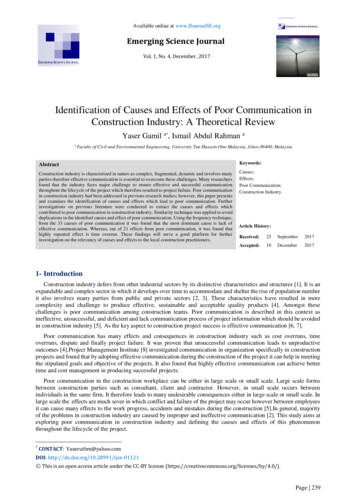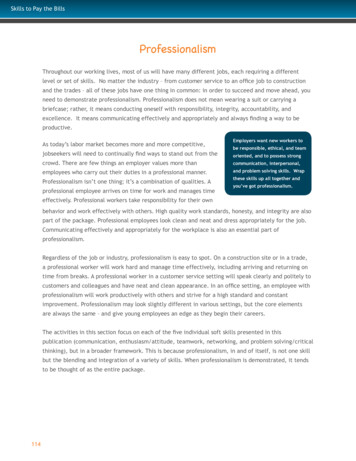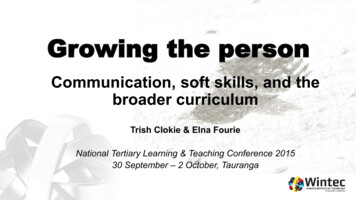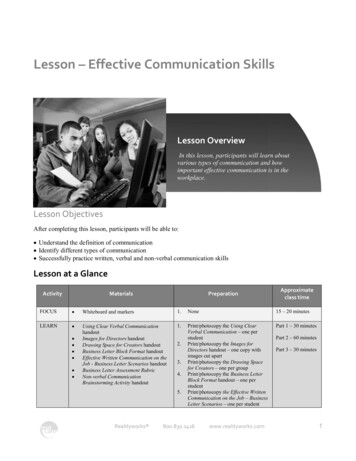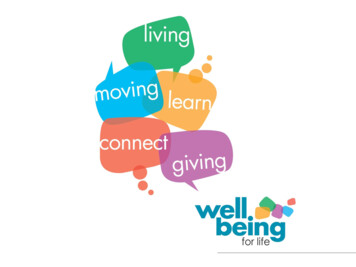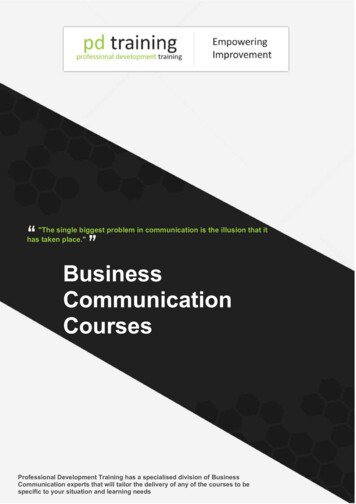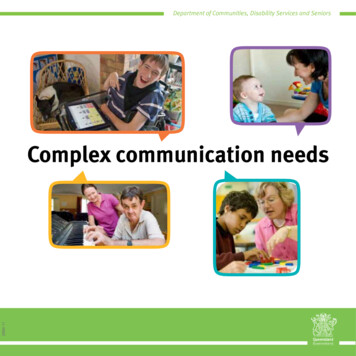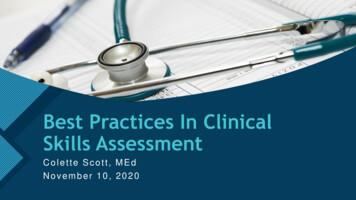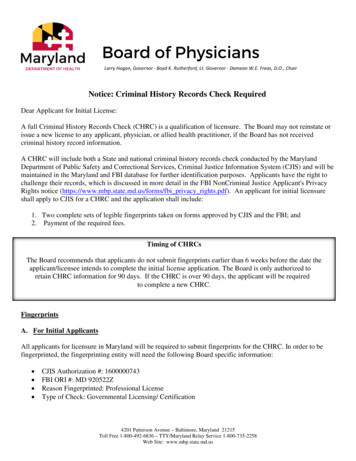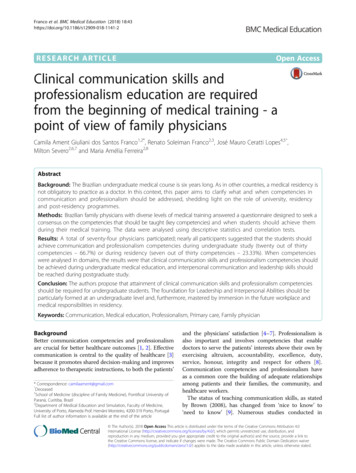
Transcription
Franco et al. BMC Medical Education (2018) ARCH ARTICLEOpen AccessClinical communication skills andprofessionalism education are requiredfrom the beginning of medical training - apoint of view of family physiciansCamila Ament Giuliani dos Santos Franco1,2*, Renato Soleiman Franco2,3, José Mauro Ceratti Lopes4,5ˆ,Milton Severo2,6,7 and Maria Amélia Ferreira2,8AbstractBackground: The Brazilian undergraduate medical course is six years long. As in other countries, a medical residency isnot obligatory to practice as a doctor. In this context, this paper aims to clarify what and when competencies incommunication and professionalism should be addressed, shedding light on the role of university, residencyand post-residency programmes.Methods: Brazilian family physicians with diverse levels of medical training answered a questionnaire designed to seek aconsensus on the competencies that should be taught (key competencies) and when students should achieve themduring their medical training. The data were analysed using descriptive statistics and correlation tests.Results: A total of seventy-four physicians participated; nearly all participants suggested that the students shouldachieve communication and professionalism competencies during undergraduate study (twenty out of thirtycompetencies – 66.7%) or during residency (seven out of thirty competencies – 23.33%). When competencieswere analysed in domains, the results were that clinical communication skills and professionalism competencies shouldbe achieved during undergraduate medical education, and interpersonal communication and leadership skills shouldbe reached during postgraduate study.Conclusion: The authors propose that attainment of clinical communication skills and professionalism competenciesshould be required for undergraduate students. The foundation for Leadership and Interpersonal Abilities should beparticularly formed at an undergraduate level and, furthermore, mastered by immersion in the future workplace andmedical responsibilities in residency.Keywords: Communication, Medical education, Professionalism, Primary care, Family physicianBackgroundBetter communication competencies and professionalismare crucial for better healthcare outcomes [1, 2]. Effectivecommunication is central to the quality of healthcare [3]because it promotes shared decision-making and improvesadherence to therapeutic instructions, to both the patients’* Correspondence: camilaament@gmail.comˆDeceased1School of Medicine (discipline of Family Medicine), Pontifical University ofParaná, Curitiba, Brazil2Department of Medical Education and Simulation, Faculty of Medicine,University of Porto, Alameda Prof. Hernâni Monteiro, 4200-319 Porto, PortugalFull list of author information is available at the end of the articleand the physicians’ satisfaction [4–7]. Professionalism isalso important and involves competencies that enabledoctors to serve the patients’ interests above their own byexercising altruism, accountability, excellence, duty,service, honour, integrity and respect for others [8].Communication competencies and professionalism haveas a common core the building of adequate relationshipsamong patients and their families, the community, andhealthcare workers.The status of teaching communication skills, as statedby Brown (2008), has changed from ‘nice to know’ to‘need to know’ [9]. Numerous studies conducted in The Author(s). 2018 Open Access This article is distributed under the terms of the Creative Commons Attribution 4.0International License (http://creativecommons.org/licenses/by/4.0/), which permits unrestricted use, distribution, andreproduction in any medium, provided you give appropriate credit to the original author(s) and the source, provide a link tothe Creative Commons license, and indicate if changes were made. The Creative Commons Public Domain Dedication o/1.0/) applies to the data made available in this article, unless otherwise stated.
Franco et al. BMC Medical Education (2018) 18:43different countries and settings have demonstrated theeffectiveness of teaching communication and professionalism during undergraduate [10, 11] and postgraduatemedical training [12, 13] for the promotion of good outcomes for patients. Communication skills and professionalism are related to the more influential aspects ofhealthcare provided by primary care doctors [14] andthey are described as being among the fundamental toolsfor family physicians [4], particularly for the treatmentof chronic diseases such as diabetes and hypertension.Undergraduate training in family medicine can promotethe improvement of competencies related to communication and professionalism [15], and as the majority ofhealthcare is initially delivered in the primary care setting, medical education must consider and empower thissetting for medical training [16].Brazilian medical training involves six years of undergraduate courses followed by a residency programmeand continued education and training. In Brazil, the residency programme is not obligatory, and after medicalschool, a physician can work as a doctor without specialisation. Since 2001, communication competencies andprofessionalism have been defined among outcomes inthe Brazilian national guidelines for medical undergraduates [17]. In 2014, the current guideline, DiretrizesCurriculares Nacionais para o Curso de Graduação emMedicina (National Curricular Guidelines for the MedicineCourse), reinforced communication competencies and professionalism [18]. The teaching of communication competencies and professionalism are now being fostered inBrazilian schools of medicine, where curricula have beenstructured to include these topics [19].Family physicians and the primary care setting havebecome more important in the public health system andin undergraduate and postgraduate medical education inBrazil [18]. Therefore, considering the importance ofteaching communication and professionalism to primarycare physicians and the importance of the government’sstimuli to include this setting in medical training, theviewpoint of family physicians with regard to medicaleducation has become important for the development ofteaching these topics.A variety of globally accepted documents on medicaltraining have pointed to professionalism and communication competencies as being the competencies thatmust be achieved [18, 20–28]. Despite being seen as crucial, the teaching, learning and practice of these competencies can be incomplete or even missing amongmedical students and physicians [29]. Finding consensuson these competencies, and aggregating them into domains or major themes, and then determining the mostappropriate time to attain these competencies shouldhelp with the design of teaching strategies. Drawing onthe importance of family medicine in medical schoolsPage 2 of 13and primary care along with the inclusion of the expertise of family physicians in the development of thesecompetencies, this study aims to do the following: 1) define key competencies (KCs) in communication and 2)shed light on when communication and professionalismKCs should be achieved during medical training.MethodsSurvey designThe research was performed between January andNovember 2015. It was developed in three phases: 1)thematic organisation of communication skill competencies and the definition of communication KCs, 2) confirmatory analysis of the themes within communicationcompetencies, and 3) investigation of when family physicians think competencies in professionalism and communication should be achieved. The definition of KCsfor professionalism was based on a systematic review byBirden et al. [30], which our research team used to conduct a thematic analysis of relevant papers on professionalism from Birden et al.’s review (the results ofwhich we have already published and presented at conferences [31]). Thus, the first two phases of this studyapply to communication and the third phase (when toachieve) is in regard to both communication and professionalism. The participants answered questions aboutthe clustering of the communication competencies, andthe professionalism competencies were touched on inpart when they answered questions about when thecompetencies should be achieved. The results, discussion and conclusions of the clustering of competenciesare only applied to the communication competencies.The thematic organisation of communication competenciesKCs for communication were thematically organised byexamining medical training reference documents andreviewing the consensus statements of clinical communication skills. This included a total of nine documents:six medical training guides from the UK, Germany, theUnited States, Canada, Australia and Brazil; and threedocuments focused on communication skills, theCalgary–Cambridge Guide, the Kalamazoo ConsensusStatement and the European consensus on learning objectives for a core communication curriculum in healthcare professions [18, 20–28].Three researchers performed a thematic organisationof these documents using a three-step process. The threeresearchers each have experience in medical educationand one has been involved in medical training and training of trainers in communication and patient-centredmedicine, for more than thirty years. Two are familyphysicians and one is a psychiatrist. In the first step, allcompetencies and learning outcomes related to communication (‘fragments’) were identified and highlighted.
Franco et al. BMC Medical Education (2018) 18:43In the second step, the fragments were grouped bycontent similarity, and descriptive themes were generated without any preconceived determinations on thepart of the researchers. These descriptive themes became the KCs, which needed to be representative ofthe core meanings of the fragments’ contents (thefragments corresponded to the highlighted learningoutcomes related to communication in the referencedocuments). Once these KCs for communication weredetermined, they were grouped into three domains:Clinical Communication Skills (CCS), closely relatedto patient care; Interpersonal Communication (IC),closely related to teamwork, multidisciplinary teamsand colleagues; and Leadership.The second phase used Qualtrics , a web-based surveysystem. The survey was sent by email to 213 doctorsfrom all regions of Brazil between April and June 2015(Additional file 1- Survey Questionnaire). The recipientshad participated in courses for trainers in family medicine under three types of professional activities: preceptors, faculty members and medical doctors. Thequestionnaire included three sections: 1) collection ofdemographic characteristics, professional activities andan estimation of the time frame within which each doctor had achieved their own competencies in communication skills and professionalism; 2) confirmation of thecommunication themes (KCs) defined by the researchersand 3) their point of view on the optimal time to requireattainment of these KCs, i.e. at the undergraduate level,during residency or after residency.In the second section of the questionnaire, to confirm if the competencies were appropriately represented by the KCs, the fragments were presented to74 subjects who were asked to choose a KC that bestrepresented the fragment’s meaning. Among thechoices was one or more of the KCs as well as othersnot included in the KCs.Statistical analysesThe categorical numerical variables were described usingcounts (percentages) and means (SD) or medians (25thpercentile and 75th percentile). To find the groups offragments that corresponded to each KC, the participants’ responses were evaluated. To identify the response patterns, we used hierarchical clustering withManhattan distance. The number of clusters was identified using fusion coefficients.To find the best time for each KC to be attained, allKCs in each domain were scored from 0 to 100. TheMann–Whitney test and Spearman’s rank correlationwere used to determine whether there were significantassociations between any KCs and the overall scores.Data were analysed using SPSS, Version 22.0.Page 3 of 13ResultsCharacteristics of the sample’s subjectsThe 74 (34.6%) participants ranged in age from 27 to59 years old, with a mean age of 37.9 years (SD 7.6).They had graduated from medical school 13.6 (mean)years ago (SD 7.8), between 1980 and 2012, and 51.4%were women. Ninety-three per cent had worked as afamily physician for 12.2 (mean) years (SD 8.0), 91.9%had worked as a preceptor for 5.4 (mean) years (SD 5.7) and 71.4% had worked as a faculty member for6.0 years (mean) (SD 5.6).Most of the participants (72.9%) had completed residency programmes in family medicine that certifiedthem as family physician specialists and 18.9% were family physician specialists without a residency. Only 8%were not family physician specialists but they hadworked in or taught primary healthcare courses. Forty-sixper cent had a master’s degree, 5.4% had a doctoral degreeand 1.3% had a post-doctorate degree.The definition of KCs in communicationThe 9 documents examined for KCs contained 88communication competencies (highlighted fragments)[18, 20–28]. Thirty-one competencies (fragments) wereidentical or very similar across the documents, leavingfifty-seven competencies. The thematic organisation categorised these 57 fragments into 18 KCs; 11 KCs were conceptually related to CCS, 5 were related to IC and 2 wererelated to Leadership.When the participants chose the KCs that best represented a particular competency’s idea and meaning, theanswers generated groups of competencies that were associated with the KCs (there was one or more competencies related to each KC). The confirmation of theseKCs by the family physicians and the percentage ofagreement are shown in Table 1, where frequency meanshow often the whole group of competencies were relatedto the KC for CCS. For the competencies in IC (10competencies) and in Leadership (7 competencies), theaggregation of competencies into groups was not considered because of the small number of items. There wereno fragments not represented by any KC.The definition of KCs for professionalism was basedon the articles referred to in the systematic review byBirden et al. [30], as relevant to this theme. The articleswere read in full and the competencies were extractedfrom the texts using thematic analysis [31]. Altruism; accountability; humanistic values; ethics; social commitment; commitment to excellence and advancement ofknowledge; reflective thinking; dealing effectively withuncertainty and changes; collaboration and teamwork;and expert knowledge were related to the competenciesof professionalism. The competencies of collaborationand teamwork were cited in two of the nine papers
Franco et al. BMC Medical Education (2018) 18:43Page 4 of 13Table 1 The percentage of agreement among Family Physicians on Key Competencies and the competencies represented by eachgroup of Key CompetenciesClinical Communication Skills (Key Competencies)Group of Competencies (Fragments) (CCS)*1345678910111244% 3%2%1%7%7%5%3%2%0%0%0%Establish a therapeutic and professional relationship4%1%42% 0%2%0%1%0%0%5%0%0%Build a suitable relationship3%49% 29% 6%7%6%1%2%0%0%0%0%Involve the bio-psycho-social context1%0%0%7%2%8%0%2%0%0%2%84%Understand the perspective of the patient and his or her family2%1%3%63% 6%2%5%2%6%0%2%11%Adapt communication according to the patient and his or her family 18% 5%3%3%71% 8%0%Communicate effectively according to given roles22%2%0%3%27% 9%10% 11% 0%10% 0%0%5%63% 0%Support decision-making based on the needs and interests of the patient 1%8%8%7%13% 3%15% 4%0%79% 12% 5%Structure and organize communication/clinical interviews6%2%0%1%37% 1%6%2%5%1%Inform patients and family adequately9%0%2%0%2%2%40% 0%0%0%14% 0%Communicate bad news appropriately5%0%0%2%0%2%4%0%87% 0%0%0%None of the Key Competencies4%3%2%1%11% 0%3%2%0%0%0%Group of Competencies (Fragments) (CCS)*Competency (Fragments)Engage patients and families to share in decision-making13%1%85%5%0%Communicate effectively with patients, families and the publicCommunicate effectively in wider roles including health advocacy, teaching,assessing and appraising. Communicate effectively about ethical issues withpatients and familyCommunicate effectively in various roles, for example, as patient advocate,teacher, manager or improvement leaderUses effective and efficient communication and management strategiesDemonstrate by listening, sharing and responding, the ability to communicateclearly, sensitively and effectively with patients and their family/careersCommunicate clearly, sensitively and effectively with patients, their relatives orother carers, and colleagues from the medical and other professions, by listening,sharing and respondingDemonstrate by listening, sharing and responding, the ability to communicateclearly, sensitively and effectively with patients and their family/careers2Building relationship (Using appropriate non-verbal behaviour, Developingrapport and Involving the patient)Shaping of relationship: involves the patient in the interaction using a patientcentered approachRecognizes the patient as a partner in shaping a relationship3Involves the patient in the interaction to establish a therapeutic relationshipusing a patient-centered approach.Relates to the patient respectfully including ensuring confidentiality, privacyand autonomy.Establish professional therapeutic relationships with patients and their familiesCreate and sustain a therapeutic, ethical relationships with patients4Gathering information (Exploration of patient’s problems and Additional skillsfor understanding the patient’s perspective)Encourage the patient to express own ideas, concerns, expectations andfeelings and accepts legitimacy of patients views and feelingUnderstand the Patient’s Perspective5Gather informationInformation: effectively collects the relevant information for the reasoningand decision-making processEffectively collects relevant information for reasoning and decision making
Franco et al. BMC Medical Education (2018) 18:43Page 5 of 13Table 1 The percentage of agreement among Family Physicians on Key Competencies and the competencies represented by eachgroup of Key Competencies (Continued)Initiating the session (Establishing initial rapport and Identifying the reason(s)for the consultation)Open the Discussion6Communication in the doctor–patient relationship: orients her communicationbehaviour along the actual concerns and the personality of the patientSocial behaviour and communication: adapts her social behaviour andcommunication to different social contexts and communication partners.Adapts own communication to the level of understanding and language ofthe patient, uses techniques aproppriates for this7Explanation and planning (Providing the correct amount and type ofinformation, Aiding accurate recall and understanding.)Information: effectively communicates the relevant information for thereasoning and decision-making processEffectively communicates relevant information for reasoning and decisionmaking. Gives information to the patient in a timely, comprehensive andmeaningful mannerElicit and synthesize accurate and relevant information, incorporating theperspectives of patients and their families8Shapes a conversation from beginning to end with regard to structure(e.g. introduction, initiating the conversation, gathering and givinginformation, planning, closing interview, setting up next meeting; timemanagement)Providing structure (Making organization overt And Attending to flow)9Communicate appropriately with difficult or violent patients; people withmental illness and vulnerable patients//Communicate appropriately in difficultcircumstances, such as when breaking bad news, and when discussing sensitiveissues, such as alcohol consumption, smoking or obesityRecognizes difficult situations and communication challenges and deals withthem sensitively and constructively10;.developing plans that reflect the patient’s health care needs and goals11Involve patients in decision-making and planning their treatment, includingcommunicating risk and benefits of management options.Engage patients and their families.Share informationExplanation and planning (Achieving a shared understanding: incorporating thepatient’s perspective and Planning: shared decision making)Share health care information and plans with patients and their families12Interpersonal Communication (Key Competencies)Elicits and explores the content of the patient’s bio-psycho-social history.Number (IC)12345678100%0%0%0%Work effectively in multidisciplinary team, adapting to theparticularities of each team and given roles72% 30% 87% 55% 25% 9%Perform consulting, helping colleagues, other professionals,and the healthcare system11% 26% 0%Communicate effectively to promote understanding and resolveconflicts, aiming to ensure the success of teamwork11% 19% 13% 30% 6%0%65% 11%82% 18%Perform teamwork, aiming to ensure patient safety6%7%0%10% 9%0%6%79%0%Communicate about ethical issues with other health professionals0%4%0%0%0%0%0%0%18% 77%None of the Key Competencies0%15% 0%5%19% 9%0%12% 0%939% 82% 6%5%11% 5%0%5%0%
Franco et al. BMC Medical Education (2018) 18:43Page 6 of 13Table 1 The percentage of agreement among Family Physicians on Key Competencies and the competencies represented by eachgroup of Key Competencies (Continued)Number (IC)Competency (Fragments)1Work effectively with physicians and other colleagues in the health careprofessions2Communicate effectively with physicians, other health professionals andhealth-related agencies3Team building and working in a team: adapts her behaviour to differentphases of team building and efficiently shapes her working style to contributeto a successful team4Shows ability to communicate effectively in multi-professional teams5Contribute to the improvement of health care delivery in teams, organizations,and systems6Act in a consultative role to other physicians, health-related agencies andpolicy-makers7Work with physicians and other colleagues in the healthcare professionsto promote understanding, manage differences, and resolve conflicts8Demonstrate by listening, sharing and responding, the ability to communicateclearly, sensitively and effectively with doctors and other health professionals.9Hand over the care of a patient to another health care professional tofacilitate continuity of safe patient care10Communicate effectively about ethical issues with health care professionals.Leadership (Key Competencies)Number (Leadership)123Demonstrate basic leadership skills94%82%80% 73%4100% 24%14%Engage in the management of human and health care resources0%9%5%0%76%81%None of the Key Competencies6%9%15% 7%0%0%5%Number (Leadership)Competency (Fragments)1Demonstrate leadership in professional practice2Work with other care providers as a team leader or member3Describe the principles and practice of leadership in health care.4Leadership: shows basic competencies in leadership skills and supports thedevelopment and maintenance of the teamwork with her behavior5Shows basic competencies in leadership skills20%5676Engage in the stewardship of health care resources.7Manage career planning, finances, and health human resources in a practicereviewed for professionalism, but almost all of the documents related to communication included collaborationand teamwork in the fields of interpersonal communication or leadership. Therefore, collaboration and teamworkwere presented in the communication competencies,namely in the KCs for IC and Leadership. Consequently,there were 9 professionalism themes represented by 12KCs (Table 2).When students should achieve professionalism andcommunication competenciesTable 2 shows the participants’ answers regarding whenstudents should achieve each KC. Of the 30 KCs (18 forcommunication and 12 for professionalism), the subjectsreported that 20 (66.7%) of the KCs should be achievedduring undergraduate medical education, 7 (23.3%) during residency, 1 (3.3%) after residency, 1 (3.3%) duringresidency or undergraduate education and 1 (3.33%) during any of these periods.When the KCs were analysed by the domains (threedomains each for communication, CCS, IC and Leadership and one domain for Professionalism), the resultsshowed that the participants believed KCs for CCS andProfessionalism should be achieved during undergraduate education, and KCs for IC and Leadership should beachieved during postgraduate study (residency and postresidency) (see Table 2).The stage of medical training at which the participantsreported they had reached professionalism and communication competencies themselves correlated significantly
Franco et al. BMC Medical Education (2018) 18:43Page 7 of 13Table 2 When students should achieve professionalism and communication competenciesCompetencySubdomainCompetenciesUnder graduate %FM Residency %After Residency %p*Communicate effectively according to given rolesCCS50.042.17.90.003Establish a therapeutic and professional relationshipCCS35.154.110.80.005Build a suitable relationshipCCS60.534.25.3 0.001Involve the bio-psycho-social contextCCS48.944.46.7 0.001Understand the perspective of the patient and hisor her familyCCS70.629.40.00.016Adapt communication according to the patientand his or her familyCCS73.821.44.8 0.001Engage patients and families to share indecision-makingCCS77.822.20.0 0.001Support decision-making based on the needs andinterests of the patientCCS71.823.15.1 0.001Structure and organize communication/clinicalinterviewsCCS59.538.12.4 0.001Communicate bad news appropriatelyCCS17.170.712.2 0.001Inform patients and family adequatelyCCS52.642.15.3 0.001Work effectively in multidisciplinary team, adaptingto the particularities of each team and given rolesIC19.469.411.1 0.001Perform consulting, helping colleagues, otherprofessionals, and the healthcare systemIC52.442.94.8 0.001Communicate effectively to promote understandingand resolve conflicts, aiming to ensure the successof teamworkIC16.353.530.20.010Perform teamwork, aiming to ensure patient safetyIC19.570.79.8 0.001Communicate about ethical issues with otherhealth professionalsIC22.261.116.70.002Demonstrate basic leadership skillsLeadership41.747.211.10.017Engage in the management of human and healthcare resourcesLeadership7.037.255.8 0.001Know and apply ethics, acting with honesty andrespecting ethical and moral valuesProfessionalism90.59.50.0 0.001Act with interest and dedicationProfessionalism100.00.00.0 0.001Prioritize patient’s/family’s/community’s interestsabove one’s ownProfessionalism64.426.78.9 0.001Recognize one’s limits and know when to requestsupportProfessionalism68.231.80.00.016Be responsible and careful in one’s actionsProfessionalism69.230.80.00.016Attempt to promote patient and/or family safetyProfessionalism89.57.92.6 0.001Act according to the highest standards of excellenceand know where to seek knowledgeProfessionalism41.736.122.20.338Be empathic and respectful, valuing the feelingsand wishes of colleagues, patients, teachers, andother professionalsProfessionalism91.95.42.7 0.001Consider the beliefs, needs, and views of patients/familiesProfessionalism81.815.92.3 0.001Reflect and have good critical skillsProfessionalism65.926.87.3 0.001Deal with uncertainty appropriately, adapting todifferent situations and contextsProfessionalism32.454.113.50.010Recognize and nurture their own physical and mental healthProfessionalism87.19.73.2 0.001p value 0.05 was considered statistically significant
Franco et al. BMC Medical Education (2018) 18:43Page 8 of 13with when they suggested students should achievethese competencies. Subjects who assumed that theirprofessionalism or communication competencies hadbeen achieved in the early stages of their medicaltraining agreed that these competencies should beachieved sooner. Participants who had completed afamily medicine residency believed that KCs for CCSshould be achieved later. The longer a participanthad spent working as a preceptor, the more theyagreed that the achievement of KCs in IC shouldoccur later (Table 3).There were no statistical differences with respectto when the domains of the competencies should bereached when considering the participants’ academicdegree, gender, age, number of years working as adoctor or number of years working as a facultymember (Table 4).DiscussionThe 18 communication KCs appeared to be widely acknowledged by family physicians as representative of the57 competencies. The physicians thought that the KCsfor CCS and Professionalism should be achieved duringundergraduate medical education and KCs for IC andLeadership skills should be reached during postgraduatestudy (residency or after).The KCs for communicationThe very low selection rate for the option ‘None of theKey Competencies (KCs)’ and the aggregation of competencies suggested that the KCs were representative of allcompetencies. The range of agreement about the grouping of the KC for CCS ranged from 37% to 87%. Evenfor the response with the least agreement, ‘KC – Structure and organise communication/clinical interviews’,Table 3 Factors associated with the belief that competencies should be developed later or soonerClinical communication skillsN (%)Median (P25-P75)74 (100)21.43 (8.33–40.00)Female38 (51.4)18.33 (7.44–33.33)Male36 (48.6)23.21 (8.33–41.67)TotalInterpersonal communication*pMedian (P25-P75)Leadership*p50.00 (25.00–50.00)Median (P25-P75)Professionalism*p50.00 (31.25–100.00)Median (P25-P75)*p12.50 (0.00–21.43)Gender0.26750.00 (25.00–50.00)0.64750.00 (25.00–50.00)50.00 (25.00–100.00)0.47550.00 (50.00–100.00)10.00 (0.00–21.43)0.61714.29 (0.00–22.32)Academic degreeGraduate35 (47.3)20.00 (0.00–38.75)Postgraduate39 (52.7)21.43 (10.56–40.00)0.37850.00 (25.00–50.00)0.48250.00 (27.08–50.00)50.00 (31.25–100.00)0.94250.00 (43.75–100.00)10.0
shed light on when communication and professionalism KCs should be achieved during medical training. Methods Survey design The research was performed between January and November 2015. It was developed in three phases: 1) thematic organisation of communication skill competen-cies and the definition of communication KCs, 2) con-

